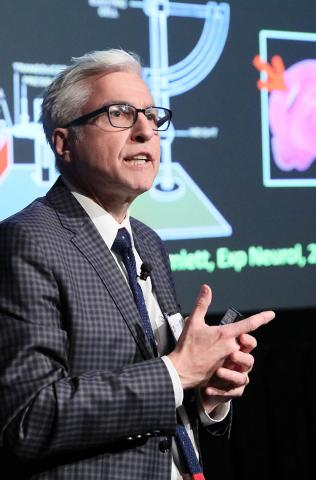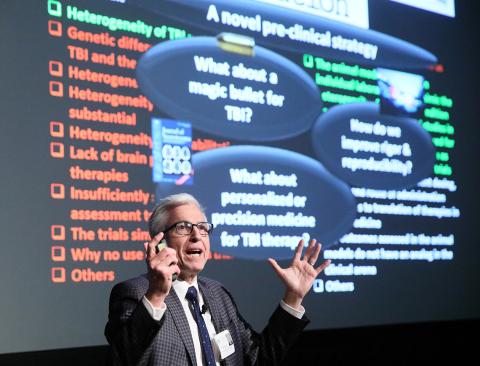On the Brain
Searching for Breakthroughs in Brain Injury Research

Photo: Chia-Chi Charlie Chang
The field of traumatic brain injury (TBI) has burst onto the public’s radar in recent years, bolstered by publicity surrounding sports-related concussions and war-related injuries. The result has been increased funding and research to find new treatments.
“Traumatic brain injury has gone wild in the last few years, with chronic traumatic encephalopathy and the recognition that concussion is not a badge of honor but is actually a disease,” said Dr. Patrick Kochanek, director, Safar Center for Resuscitation Research at the University of Pittsburgh School of Medicine. Kochanek, also a professor of critical care medicine, anesthesiology and pediatrics, spoke at a recent CC Grand Rounds Great Teachers lecture in Lipsett Amphitheater.
TBI can cause a range of symptoms, depending on the severity. Long-term effects can include difficulties with cognition, communication and mental health.
“It’s being linked to every chronic neurodegenerative disease under the sun, which has helped spearhead this tremendous interest, so I’ve been calling it the golden age of traumatic brain injury research,” said Kochanek, noting a flurry of collaborative studies now funded by NIH, the Department of Defense, the National Football League and other organizations. “And the trickle into severe traumatic brain injury from all of this has also been spectacular.”
Kochanek attributed current progress to a multi-center consortia approach that honors the vision of the late Dr. Peter Safar, the namesake of the institution he directs. Using this strategy, researchers across multiple sites are converging to identify new biomarkers of brain injury and test therapies in preclinical and clinical studies.
Over the past decade, TBI research has stagnated. Some standard treatments for acute TBI have been archaic and crude, such as intracranial pressure monitoring, which involves inserting a catheter into a drilled hole in the skull. But new drugs tested in clinical trials proved ineffective. Not one neuroprotective therapy made it from bench to bedside, said Kochanek.
The roadblocks have been numerous, from genetic differences in response to injury and treatment to the inability to replicate study results. Preclinical studies also have uncertainties. Do animal models truly mimic the disease? And what’s the proper dosing between species?
It’s possible that treating the various kinds of TBI—contusion, edema, hematoma, axonal injury among them—may require different precision therapies.
“These diseases, although they’re all TBI, are pretty different and the pathobiology, the treatment for them, and the monitoring and long-term outcome would be expected to be different,” said Kochanek. “So robust therapy that would show benefit across all of them would be necessary.”
One major multi-center initiative is Operation Brain Trauma Therapy (OBTT), a U.S. Army-funded preclinical drug and biomarker screening consortium for head injury. Researchers at multiple centers are testing therapies across multiple models at the same time.
Two biomarkers of interest to DoD are the proteins UCH-L1 and GFAP, which are measured across all the studies. A scoring matrix rates results for cognitive outcome, motor function, lesion volume and tissue loss. So far, after testing more than 1,500 rats and building a 5,000+ biomarker repository, researchers have made some interesting findings.
“Our first strategy,” said Kochanek, “was to go after low-hanging fruit drugs, FDA-approved for other uses already that could be rapidly translated.”
They began testing 12 promising drugs and became disheartened to learn that the first 4 showed no improved cognitive outcome. There was little literature related to TBI on the fifth drug, levetiracetam, though they found a study to try to replicate. Success! It was the only drug to produce significant benefit on cognitive outcome.
“Here’s a drug that’s a neuro-developed agent and, of only one preclinical study in TBI, had the most points [in our matrix],” said Kochanek.
The research teams also were encouraged by the sixth drug, glyburide, which reduced necrosis and swelling in the contusion model, the only drug of the 12 to reduce contusion volume 3 weeks after injury.
The biomarkers also proved highly predictive. In the levetiracetam study, the 24-hour GFAP levels predicted a reduction in 21-day lesion volume.

Photo: Chia-Chi Charlie Chang
“This was really exciting, that a serum biomarker could [be predictive] in a rigorous, multi-center study,” said Kochanek. “It did not in the other models, which did not show hemispheric tissue loss.”
Last year, the FDA approved the first blood test to evaluate mild concussion in adults based on clinical data generated by OBTT. The test measures levels of UCH-L1 and GFAP released from the brain into blood within hours of a head injury.
“I think the biomarker story like this is really going to catch on,” not only for diagnosing TBI, but also for other uses such as predicting risk of future symptoms and in trauma units.
The remaining 6 drugs in the 12-drug study are still in testing, along with additional biomarkers. Researchers continue looking for personalized therapies that might work for a single TBI type, such as contusion, as well as a magic bullet that might work in all models of TBI.
Preliminary experiments suggest the multi-center strategy can be useful in performing rigorous, reproducible testing, said Kochanek. The OBTT model has received a great deal of press and is generating interest in other fields of acute medicine and neurocritical care.
